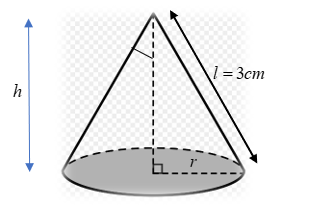
Water is dripping out from a conical funnel at the uniform rate of $4c{m^3}/{\text{sec}}$ . When the slant height of the water is $3cm$ , find the rate of the decrease of the slant height of the water, given that the vertical angle of the funnel is ${120^ \circ }$ .
Answer
608.7k+ views
Hint: Apply the derivative methods. Rate of decrease of volume is given to us. Use that information.

It’s given that the vertical angle is ${120^ \circ }$ so half of it will be ${60^ \circ }$ . Slant height l is given to us as $3cm$ . Let the height be h and radius be r. The question says, water is dripping out from a conical funnel at the uniform rate of $4c{m^3}/{\text{sec}}$ . In case of a full canonical funnel with water, we say volume is equal to the water present in the funnel. Since, water is decreasing with the uniform rate then we can say $\dfrac{{dV}}{{dt}} = - 4$ . The unit $c{m^3}/{\text{sec}}$ also confirms the fact that it’s nothing but volume. One might think that why the negative sign we are taking? It's because of the fact that the water is decreasing by time. For that decrement, we are using negative signs. Now,
$
\sin {60^ \circ } = \dfrac{r}{l} \Rightarrow \dfrac{{\sqrt 3 }}{2} = \dfrac{r}{l} \Rightarrow r = \dfrac{{\sqrt 3 l}}{2} \\
\cos {60^ \circ } = \dfrac{h}{l} \Rightarrow \dfrac{1}{2} = \dfrac{h}{l} \Rightarrow h = \dfrac{l}{2} \\
$
We know the formula for volume of the cone,
\[
V = \dfrac{1}{3}\pi {r^2}h \\
\Rightarrow V = \dfrac{1}{3}\pi {(\dfrac{{\sqrt 3 l}}{2})^2}\dfrac{l}{2}{\text{ }}[r = \dfrac{{\sqrt 3 l}}{2},h = \dfrac{l}{2}] \\
\Rightarrow V = \dfrac{1}{{{3}}} \times \pi \times \dfrac{{{3}{l^2}}}{4} \times \dfrac{l}{2} \\
\Rightarrow V = \dfrac{1}{8}\pi {l^3} \\
\]
On differentiating we’ll be getting,
$
\dfrac{{dV}}{{dt}} = \dfrac{\pi }{8}3{l^2}\dfrac{{dl}}{{dt}} \\
\Rightarrow - 4 = \dfrac{\pi }{8}3{(3)^2}\dfrac{{dl}}{{dt}}{\text{ }}[\dfrac{{dV}}{{dt}} = - 4c{m^3}/\sec ,l = 3 cm] \\
\Rightarrow \dfrac{{dl}}{{dt}} = \dfrac{{ - 4 \times 8}}{{27\pi }} \\
\Rightarrow \dfrac{{dl}}{{dt}} = \dfrac{{ - 32}}{{27\pi }} \\
$
Hence, the rate of the decrease of the slant height of the water is $\dfrac{{ - 32}}{{27\pi }}$ .
Note: The toughest part in this question is to recognise the concept. Once you get it as the question of rates then half of the question is finished there itself. After that, we need to find the rate given to us and then use its formula. It’ll lead us to the solution.

It’s given that the vertical angle is ${120^ \circ }$ so half of it will be ${60^ \circ }$ . Slant height l is given to us as $3cm$ . Let the height be h and radius be r. The question says, water is dripping out from a conical funnel at the uniform rate of $4c{m^3}/{\text{sec}}$ . In case of a full canonical funnel with water, we say volume is equal to the water present in the funnel. Since, water is decreasing with the uniform rate then we can say $\dfrac{{dV}}{{dt}} = - 4$ . The unit $c{m^3}/{\text{sec}}$ also confirms the fact that it’s nothing but volume. One might think that why the negative sign we are taking? It's because of the fact that the water is decreasing by time. For that decrement, we are using negative signs. Now,
$
\sin {60^ \circ } = \dfrac{r}{l} \Rightarrow \dfrac{{\sqrt 3 }}{2} = \dfrac{r}{l} \Rightarrow r = \dfrac{{\sqrt 3 l}}{2} \\
\cos {60^ \circ } = \dfrac{h}{l} \Rightarrow \dfrac{1}{2} = \dfrac{h}{l} \Rightarrow h = \dfrac{l}{2} \\
$
We know the formula for volume of the cone,
\[
V = \dfrac{1}{3}\pi {r^2}h \\
\Rightarrow V = \dfrac{1}{3}\pi {(\dfrac{{\sqrt 3 l}}{2})^2}\dfrac{l}{2}{\text{ }}[r = \dfrac{{\sqrt 3 l}}{2},h = \dfrac{l}{2}] \\
\Rightarrow V = \dfrac{1}{{{3}}} \times \pi \times \dfrac{{{3}{l^2}}}{4} \times \dfrac{l}{2} \\
\Rightarrow V = \dfrac{1}{8}\pi {l^3} \\
\]
On differentiating we’ll be getting,
$
\dfrac{{dV}}{{dt}} = \dfrac{\pi }{8}3{l^2}\dfrac{{dl}}{{dt}} \\
\Rightarrow - 4 = \dfrac{\pi }{8}3{(3)^2}\dfrac{{dl}}{{dt}}{\text{ }}[\dfrac{{dV}}{{dt}} = - 4c{m^3}/\sec ,l = 3 cm] \\
\Rightarrow \dfrac{{dl}}{{dt}} = \dfrac{{ - 4 \times 8}}{{27\pi }} \\
\Rightarrow \dfrac{{dl}}{{dt}} = \dfrac{{ - 32}}{{27\pi }} \\
$
Hence, the rate of the decrease of the slant height of the water is $\dfrac{{ - 32}}{{27\pi }}$ .
Note: The toughest part in this question is to recognise the concept. Once you get it as the question of rates then half of the question is finished there itself. After that, we need to find the rate given to us and then use its formula. It’ll lead us to the solution.
Recently Updated Pages
Master Class 10 General Knowledge: Engaging Questions & Answers for Success

Master Class 10 Computer Science: Engaging Questions & Answers for Success

Master Class 10 English: Engaging Questions & Answers for Success

Master Class 10 Social Science: Engaging Questions & Answers for Success

Master Class 10 Maths: Engaging Questions & Answers for Success

Master Class 10 Science: Engaging Questions & Answers for Success

Trending doubts
The shortest day of the year in India

Why is there a time difference of about 5 hours between class 10 social science CBSE

Write a letter to the principal requesting him to grant class 10 english CBSE

What is the median of the first 10 natural numbers class 10 maths CBSE

The Equation xxx + 2 is Satisfied when x is Equal to Class 10 Maths

State and prove converse of BPT Basic Proportionality class 10 maths CBSE




